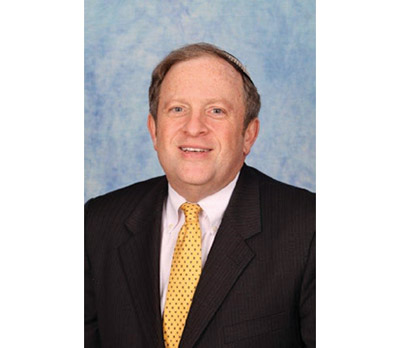
I traveled back 200 years in time in 30 minutes two weeks ago.
My dearly departed father was a committed Conservative Jew whose best friend was a Skverer chassid. What began as a business relationship developed into an unlikely yedidim k’nafshiim friendship. They took trips to Israel together and bought cars together. My father ordered New Square’s first New York Times subscription for him, and he left a bag of challahs and cake on our doorstep every Friday afternoon. He and his wife came to our simchas, and my parents went to the simchas of their 15 children. They are truly special people: modest, intelligent, welcoming and caring.
When I got the call that this chassid’s brother died, I quickly drove (on an hour’s notice—in New Square they take kavod hameis very seriously) to New Square for the funeral.
Though only 30 minutes from Teaneck, New Square is a parallel universe. There are blue signs along the sidewalks on one side of the street (for men), and pink signs on the other side. Women who live in New Square are not allowed to drive (Saudi Arabia’s policy change hasn’t made it to Rockland County yet). The language spoken and most of the signs are in Yiddish. All the men are dressed in black and white chassidish garb. There are few outsiders; there’s only one road in and out of New Square.
It was a very different type of funeral. Though the ground was covered with 3 inches of newly fallen snow and the temperature was 30 degrees, everyone gathered on the sidewalk in front of the huge beis midrash around the casket. After just a Keil Maleh prayer for the deceased without any eulogies, eight men put the casket on their shoulders and began walking in the snow, in between houses, to the cemetery (with about 100 men in tow). A short stop was made in front of the home of the deceased, where the female mourners came out to pay their respects.
When the funeral procession arrived at the cemetery, the casket was placed on a stand, and a washing cup was placed on top of it. Then a fellow yelled out “hakafos.” Men started running silently, arm in arm around the casket. After going around the casket once, they stopped; the fellow would then count out the number of the next hakafah, and they repeated this process a total of seven times. As they did this, men (there were no women at the cemetery) threw coins over their heads, trying to get them into the washing cup. When I asked what was going on, one of the chassidim told me that it was Kabbalistic.
I must admit I felt like I was in a Star Trek episode where the Enterprise encounters humans whose ancestors had left Earth generations ago and developed very differently.
However, before I left New Square, I was reminded that these men and I are on the same page, literally.
After the funeral, I davened Mincha in the huge New Square beis midrash. A fellow was distributing flyers about Daf Yomi starting Masechet Avoda Zara that day. Some of it was in Yiddish, but the excitement about the new tractate was palpable. “Finish it two days early and make a siyum on Erev Pesach for the first borns your life,” it proclaimed. I had taken out my Masechet Avoda Zara earlier that day.
My rebbe, Rav Aharon Lichtenstein, reminded us that we instinctively feel that we have more in common with non-observant Jews. They dress like us and surf the internet like us—they literally and figuratively speak the same language. Some of us grew up in that world, and most of us work in that world. We participate together in our Jewish Federations, and we will celebrate Israel’s 70th anniversary together this spring.
However, Rav Lichtenstein reminded us, our chareidi brethren “learn the same Tosfosim as us.” Their daily schedule revolves around minyanim like ours, their weekly schedule revolves around Shabbos, and their annual calendar is based on similar preparations and celebrations for yamim tovim. Most of the sefarim in their homes are the same as ours, and like us, they go to great lengths to inspire their children to be shomrei Torah u’mitzvot.
We are annoyed, and at times downright disgusted, about the latest news from Israel: anti-army registration protests blocking the roads, the Kotel controversy, politics battles over convenience stores open on Shabbos, who is a Jew, who is a rabbi, etc.
“Kol Yisrael areivim zeh bazeh” is not just a kiruv slogan. It informs our relationship with our brothers and sisters to the right as well. It’s critical that we convey this message to our children, grandchildren and students. It’s appropriate to verbalize “Chillul Hashem” in front of children when we see obviously frum people in handcuffs on the news. We must also say “Kiddush Hashem” when we see chareidim do extraordinarily kind, upstanding or pious acts.
What unites all observant Jews is greater than what divides us.
By Rabbi Perry Tirschwell









